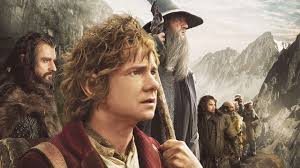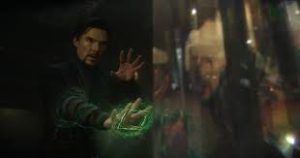FANTASY ISLANDS: Movie Reviews of The Hobbit: The Battle of the Five Armies and Into the Woods
Posted: December 30, 2014 | Author: Donald | Filed under: Uncategorized | Tags: Anna Kendricks, Cate Blanchett, Christopher Lee, Dion Beebe, Emily Blunt, Fran Walsh, Guillermo del Toro, Hugo Weaving, Ian McKellen, Into the Woods, James Horton, James Lapine, Johnny Depp, Martin Freeman, Meryl Streep, Orlando Bloom, Peter Jackson, Philippa Boyens, Rob Marshall, Stephen Soundheim, The Battle of the Five Armies, The Hobbit, Wyatt Smith | 6 Comments »First, a word from our sponsors. Ever wonder what a reader for a contest or agency thinks when he reads your screenplay? Check out my new e-book published on Amazon: Rantings and Ravings of a Screenplay Reader, including my series of essays, What I Learned Reading for Contests This Year, and my film reviews of 2013. Only $2.99. http://ow.ly/xN31r
Warning: SPOILERS
 The latest entry of The Hobbit franchise is called The Battle of the Five Armies, and I guess I have to first say that I found the title a tad puzzling because I only counted four…armies, that is. There were elves, dwarves, man and orcs.
The latest entry of The Hobbit franchise is called The Battle of the Five Armies, and I guess I have to first say that I found the title a tad puzzling because I only counted four…armies, that is. There were elves, dwarves, man and orcs.
I guess the fifth comes about if you divide those orcky things into two different factions, but, I don’t know, that sorta felt like cheating to me.
At any rate, I think the story of J.R.R. Tolkien’s prequel to The Lord of the Rings could be used as a metaphor for filmmaker Peter Jackson and his production of this final installment of the adventures of a little person called Bilbo Baggins. Read the rest of this entry »
Movie Review of CLOUD ATLAS by Howard Casner
Posted: November 13, 2012 | Author: Donald | Filed under: Uncategorized | Tags: Andy Wachowski, Ben Whishaw, Cloud Atlas, Doona Bae, Hallie Berry, Hugo Weaving, Jim Sturgess, Lana Wachowski, Susan Sarandon, Tom hanks, Tom Twyker | 1 Comment »Cloud Atlas the movie stars Frank Griebe and John Toll as the Cinematographers; Huge Bateup and Uli Hanisch as the Production Designers; Rebecca Alleway and Peter Walpole as the Set Designers; Kym Barett and Pierre-Yves Gayraud as the Costume Designers; and a cast of thousands when it comes to Makeup and Art Direction. There are also some actors involved, but they’re all pretty much chopped liver by the time the credits roll.
The movie, for those not on twitter and facebook, contains six story lines set in six different periods of time, including the future as well as the future future. The basic themes seem to be that we’re all connected; everything that happens is cause and effect; and that the flapping of a butterfly’s wings in Kansas can cause a tsunami in Japan. Except it’s not really.
In fact, as the movie jumps from time period to time period and story to story (as a friend of a friend said, it’s the perfect movie for those with ADD), no one character or event in one time period has any affect on any character or event in another time period. Or if they did, the writers (those V for Vendetta/Matrix welding Wachowski siblings, Lana and Andy, as well as Tom, Run Lola Run, Twyker, all of whom also directed) did a very good job of keeping it to themselves. True, there are overlaps. A book from one period, letters from another, a piece of middle brow music that people go gaga over for some unclear reason, all end up in another era. But that’s not a connection. That’s a coincidence. And of the extremely forced variety. Coincidence and connection are not the same thing, no matter how much new age mumbo jumbo you want to throw at it. Or if it is, the filmmakers have a totally different understanding of butterflies and tsunamis that I do (which is more than quite possible).
In the end, there’s only one reason to have made this movie and that is the opportunity to do a tour de force thingy by creating six difference films in six different styles (Bladerunner, Brideshead Revisited/Merchant-Ivory, a 1970’s crime drama cum social ills action movie, etc.), all using the same set of actors. And if the filmmakers had pulled that off, what an amazing film it would have been.
But alas, the only section that really hits its mark is the Bladerunner type story about replicants in a futuristic New Seoul. This story has the best acting (Jim Sturgess and Doona Bae in the leads); it hits its emotional mark of doomed lovers on the run (a 22nd Century take on They Live By Night); and the visual aspects of this section meld well and don’t overpower the human (well, replicant, but let’s not be petty) element. For the other sections, the filmmakers can’t seem to get the styles or rhythms quite right with the story set further in the future almost impossible to follow.
And then there’s the acting. The biggest names are Tom Hanks, Susan Sarandon and Hallie Berry. Sarandon isn’t given much to do. Hallie Berry comes across well enough, especially in the 1970’s action film; all in all, her roles don’t require a great range (and there seem to be little difference in her ambitious investigative reporter and futuristic alien). But (to paraphrase Pauline Kael in talking about Norma Shearer) oh, that Hanks. Perhaps because he is so recognizable no matter what thickness of make up and prosthetics are slathered on, he felt the need to overplay every role to really remind people that he really isn’t who you think he is—but the further he tried to get away from himself, the closer he got.
The best performers come from the younger generation, like Sturgess and Bae as well as Ben Whishaw, the perpetually pouting English actor with the big hair. They seem a bit more comfortable playing their wide range of roles (though the make up for Bae lets her down in the anti-slavery tract section). And Hugo Weaving is a hoot in his Nurse Diesel/Ratchett turn, this time named Nurse Noakes.
In the end, Cloud Atlas is ambitious and often overpowering to look at. But in execution, to be cruel and ruthlessly honest, it comes across more as the perfect choice for bad movie night where everyone can yell out comments as the scenes go by. One suggestion: in the 1970’s film, when Hanks, coiffed in the typical top and sideburns of the day, and Berry go outside and Berry asks if it’s okay to smoke and Hanks says, I’m cool—yell out, not with that hairstyle, you’re not.










 Two films have opened of late with heroes who tune into spiritual forces for guidance in their lives, forces outside the natural world around us.
Two films have opened of late with heroes who tune into spiritual forces for guidance in their lives, forces outside the natural world around us.
